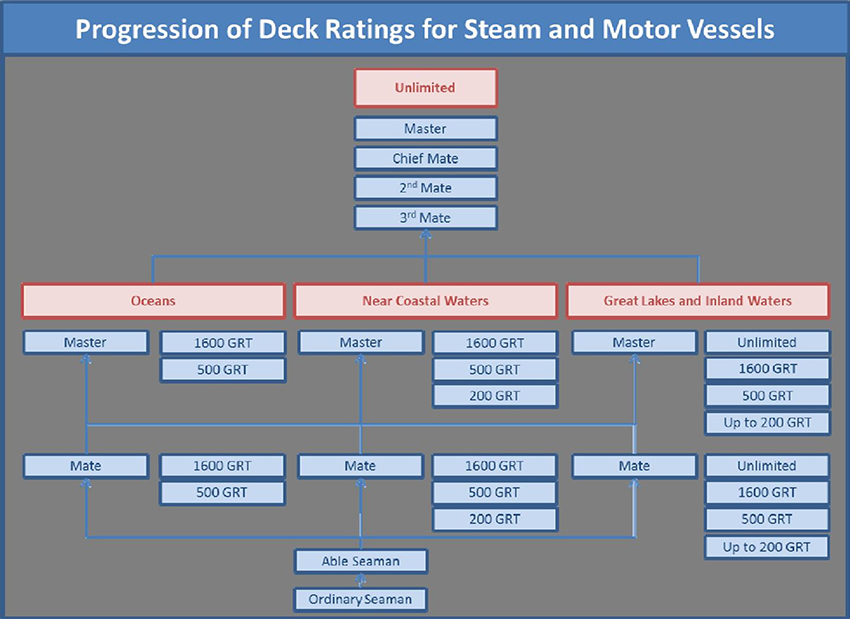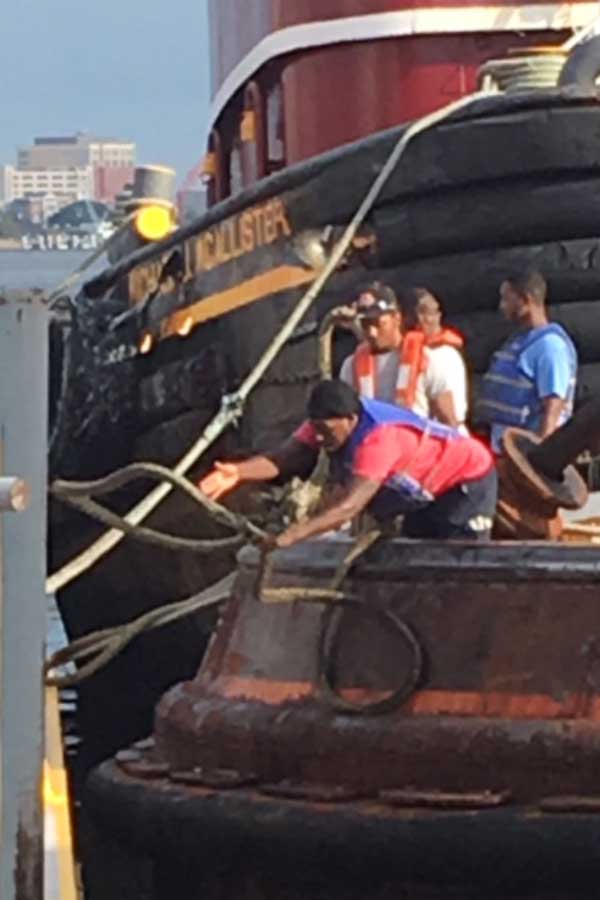Deck Department
What type of work would I do every day?
General Steam and Motor Vessels – Deck Department Overview
Although there are still sailing vessels on the sea, the majority of commerce in the modern era is on vessels with internal engines, and fall into the general category of Steam and Motor Vessels. These are the tankers, ocean liners, and other large vessels of America’s rivers, lakes, and oceans. Steam and Motor Vessels are divided into three departments – Deck, Engine, and Steward.
Members of any department are broken into categories of “licensed” and “unlicensed”. Licensed members of the deck are usually officers with significant responsibilities that include a “navigational watch”. Unlicensed members are usually seaman with general responsibilities, though they will sometimes carry an endorsement for navigational watch as well.
A common deck crew for a ship includes the following roles:
1.Ordinary Seaman An unlicensed member of the deck department who serves as an apprentice to become an Able Seaman. An OS does not usually stand watch, but is primarily focused on routine jobs of cleaning, performing basic maintenance, swabbing the decks, fixing ropes, etc. In anticipation of watch standing exams, the OS will also work on the ship’s bridge to learn necessary skills at helmsmanship.
2.Able Seaman An unlicensed member of the deck department who stands watch as a helmsman and a lookout. AB also operate deck machinery and lifesaving equipment, as well as maintenance duties associated with Ordinary Seaman.
3.Mate A licensed member of the deck department, typically performing qualified duties not performed by the Captain. The term “Mate” in this hierarchy is a bit generic – on larger vessels Mates are divided into different classes (3rd, 2nd, Chief), while on medium-sized and smaller vessels, the Mate performs all the licensed duties not performed by the Captain.
4.Third Mate A licensed member of the deck department who is generally focused on watch standing and safety. Traditionally, the Third Mate stands an “8 – 12” watch, from 8:00 a.m. until 12:00 p.m. and 8:00 p.m. until midnight. The Third Mate must be fluent in English in order to read charts and nautical publications, understand weather and safety messages, communicate with other ships and coast stations, and to successfully interact with a multilingual crew. He/she must also understand the ship’s construction and physics in order to manage emergencies at sea, and to load cargo in the most precise and balanced manner.
5.Second Mate A licensed member of the deck department who is primarily focused on watch keeping and navigation. The Second Mate may also serve as the ship’s Medical Officer. Traditionally, the Second Mate stands a “12 – 4” watch; from midnight until 4:00 a.m. and noon until 4:00 p.m. The Second Mate must be fluent in English in order to read charts and nautical publications, understand weather and safety messages, communicate with other ships and coast stations, and to successfully interact with a multi-lingual crew. He/she must also understand the ship’s construction and physics in order to manage emergencies at sea, and to load cargo in the most precise and balanced manner.
6.Chief Mate A licensed member of the deck department who is almost always a watch stander and in charge of the ship’s cargo and deck crew. Traditionally, the chief mate stands a “4 – 8” watch; from 4:00 a.m. until 8:00 a.m. and 4:00 p.m. until 8:00 p.m. The Chief Mate is responsible to the Captain for the safety and security of the ship. Responsibilities include the crew’s welfare and training in areas such as safety, firefighting, search and rescue. The Chief Mate is second in command on merchant ships that do not carry a staff Captain. In terms of managing cargo, a ship is balanced precariously under the best of conditions upon the water and is subject to a number of forces, such as wind, swells, and storms which could capsize it. The Chief Mate uses tools like ballasting and load balancing to optimize the ship’s performance for the type of environment expected to be encountered.
7.Master Mariner A licensed member of the deck department who serves as Captain. The Captain is responsible for the safe and efficient operation of the vessel, including cargo operations, navigation, crew management and ensuring that the vessel complies with local and international laws, as well as company and flag state policies. The Master Mariner commands and manages all ship’s personnel, and typically is in charge of the ship’s accounting, payrolls, and inventories. The Master Mariner is responsible for responding to and reporting in case of accidents and incidents, and in case of injuries and illness among the ship’s crew and passengers.
The makeup of the crew will differ on the size of the vessel and the distance the vessel will travel from inland shores. Within the Coast Guard’s system of licensing, an individual might start as a seaman on a particular size vessel in a specific type of water, and then work upward toward increasing sets of responsibility, increasing vessel sizes, and increasingly distant waters.
Navigable waters are differentiated in the following manner:
- Great Lakes and Inland Waters Waters within the official boundary lines of the United States, as defined in the Code of Federal Regulations, Title 46, Part 7. The Great Lakes also form a separate designation for specific route endorsements.
- Near Coastal Waters Ocean waters not more than 200 miles offshore.
- Oceans Waters seaward of the boundary lines of the United States, as defined in the Code of Federal Regulations, Title 46, Part 7.

The progression does not have to be linear. Individuals can always move sideways between different sized vessels and different waters. However they need to accumulate the amount of sea service necessary on that type of vessel or in that type of water in order to apply for the next level of license.

Line handling practice and McAllister. Students (Barry Mullen, Ty Ballance, Brendan McLean and Marcus Timmson) practice line-handling at their internship with McAllister Towing in Norfolk, VA. (August 2016)
Apply Now
Apply Now For The TRLMI Boot Camp
